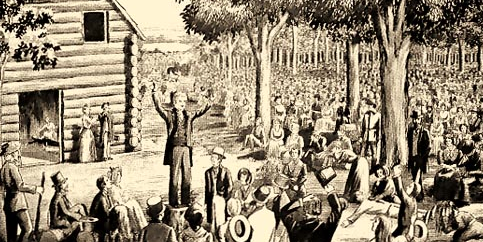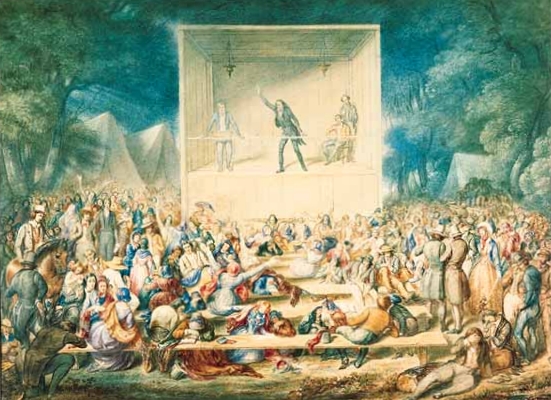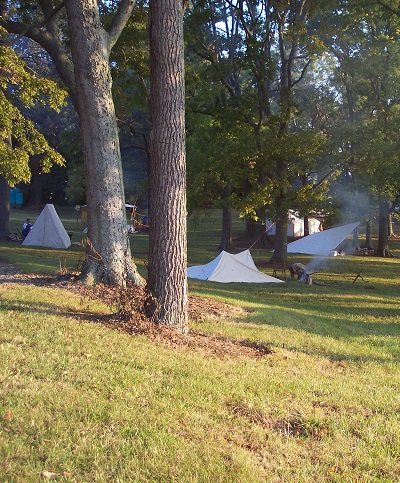By Tom Ruley

In 1790, the population of Kentucky was 73,677. In 1800, the population was 220,955. Between 1794 and 1800, the national membership of the Methodist Church decreased from 67,643 to 61,351. Kentucky’s population almost triples, and yet church population declines! This would soon change when hearts would be transformed by a mighty move of God that would become known as the Second Great Awakening, which began in the wilderness of Kentucky.
The original Red River Presbyterian church was located near Red River, near Maulding Fort, and about three miles northeast of Adairville, Kentucky. Maulding’s Fort was built in 1780 by early Scotch-Irish settlers for protection against the Indians. Graves and gravestones in the churchyard of Red River tell their own story. They mark the resting places of many of those who came, principally by way of two ports: Philadelphia and Charleston, to Kentucky through Virginia and North Carolina. The tombstone of one man born in the highlands of Scotland bears an inscription of the Twenty-third Psalm written in Gaelic. Generals, Colonels, Majors and other soldiers who fought in our country’s wars from the beginning are buried there. There is even the grave of one who fought in the Battle of Waterloo. But more important than the graveyard are the events that took place in the church which not only changed the hearts of men but changed the moral future of our nation.

Almost two hundred years ago, revival swept through the United States; this movement was called the Second Great Awakening. This revival began in June of 1800 in Logan County, Kentucky, at the Red River Meeting House near the present day community of Schochoh. The pastor of this church was Reverend James McGready.
McGready was born about 1760 in Pennsylvania to Scotch Irish Presbyterian parents who moved to North Carolina in l778. When he was older, McGready returned to Pennsylvania to study under two Presbyterian evangelists: Joseph Smith and John McMillian, who taught him to be a fiery preacher. In 1788, he returned to North Carolina where his intense preaching met with stiff opposition from the “better” classes of people whom he charged with hypocrisy, materialism and sin. McGready left North Carolina after his life was threatened; blood smeared on his pulpit convinced him that his life was in danger and he moved to Logan County, Kentucky, to an area known as Rogue’s Harbor or Satan’s Stronghold. He took charge of three small churches: the Red River, Muddy River and Gasper River Churches (1797); and for the next two years he preached without any great deal of success. Yet, he did convince his small congregations to fast on the third Saturday of each month and to pray on Saturday nights and Sunday mornings for the conversion of sinners in Logan County. McGready worked hard, preaching and praying during these two years with steady results, but nothing spectacular happened until the power of God manifested itself at a service in the Red River Church and the Gasper River Church in July of 1799. When revival broke out, dozens of members in the congregations were ‘slain in the spirit’ as the Holy Spirit moved in the services. When the news spread around the countryside, anticipation for what might happen at the next meeting stirred the curiosity of everyone and interest soared. But, a cold winter caused larger meetings to be postponed in the overflowing churches. In June of 1800, several hundred devout Christians met for a communion service at the Red River Meeting House. The congregation was composed of McGready’s three churches. McGready was assisted by four other men: John Rankin and Reverend William Hodge, also two brothers named John and William McGee.

People came from a one hundred mile radius to attend the four day communion service and this became known as the first camp meeting. Crowds came with camping supplies so they could stay through the entire meeting time. The first three days were pretty normal with people praying, rejoicing and tears of joy. The services came to their peak on the last day when John McGee stood to give the closing exhortation which he described in these words: “I…exhorted them to let the Lord omnipotent reign in their hearts, and submit to Him, and their souls should live…I turned again and losing sight of fear of man, I went through the house shouting and exhorting with all possible ecstasy and energy, and the floor was soon covered by the slain.”
After the Red River meetings, news of the happenings there spread quickly and McGready decided to make the most of it by holding a communion meeting at the Gasper River Church and publicized it would be greater in number and spiritual movements. The services were held continuously from dawn until dusk with the preachers rotating their sermons. It was impossible for everyone to be seated in the meeting house; therefore, services were held inside while also outside in the open air. McGready described the miraculous happenings: “No person seemed to wish to go home–hunger and sleep seems to affect nobody–eternal things were the vast concern. Here awakenings and converting work was to be found in every part of the multitude. Sober professors, who had been communicants for many years, now lying prostrate on the ground, crying out in such language as this: ‘O! How I would have despised any person a few days ago, who would have acted as I am doing now! But I cannot help it!’ Persons of every description, white and black, were to be found in every part of the multitude…crying out for mercy in the most extreme distress.”
This mighty move of God spread to other churches in various parts of the United States. It burned as wildfire, consuming the hearts of everyone in its path. The Red River revival is an important event in our Christian heritage and has become known as the Second Great Awakening.
Anyone who has done any historical research will know that the more you study on a subject the more contradictions you may encounter. This is especially true when some accounts rely on a person’s memory or point of view. Arguing over details is a job best left to historians and since the purpose here is not to prove or disprove facts, but to show the importance of what began almost 200 years ago in a little log church in Logan County, Kentucky.
Sources:
Religion in Antebellum Kentucky by John B. Boles
Exploring Evangelism by Mendell Taylor
“Red River Meeting House” by Ruston Flowers
“Red River Church and the Revival of 1800″ by Rev. Hughlan P. Richey
“A Look Forward into Our Past” by Frank Jarboe.